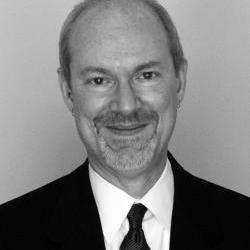Doctor Atomic is American composer John Adams’ third major opera based on historical figures and situations (after Nixon in China (1987) and The Death of Klinghoffer (1991)). Doctor Atomic, first performed in San Francisco in 2005, explores the final stages of creation of the first atomic bomb at a secret New Mexico facility in June and July 1945, ending with the first successful nuclear explosion on 16 July 1945. The libretto was assembled by frequent Adams collaborator Peter Sellars from declassified United States government documents, memoirs of participants in the Manhattan Project and other documentary sources, as well as from poetry by Muriel Rukeyser, the Bhagavad Gita, Charles Baudelaire and John Donne.
The 2008 Metropolitan Opera production is by British film director Penny Woolcock, who had previously made a film of Adams’ The Death of Klinghoffer. Several of the original San Francisco singers also appear in this production: Gerald Finley (as physicist and leader of the project J. Robert Oppenheimer), Richard Paul Fink, Thomas Glenn (as scientists Edward Teller and Robert Wilson), and Eric Owens (as General Leslie Groves); Alan Gilbert conducted.
Like Adams’s other operas, Doctor Atomic is a series of character studies, and although there is drama implicit in the scenario of the Manhattan Project, Adams instead explores the thoughts and doubts of those involved. The emphasis is on words and emotions, which makes the close-ups of video ideal.
The principals are all excellent, but pride of place goes to baritone Gerald Finley, who has taken the role of Oppenheimer in all productions to date. He is tireless as a singer and riveting as a character, always projecting the essence of the difficult music that Adams has written for him, especially in the sensuous Act I, scene 2 aria setting Baudelaire’s “A Hemisphere in a Head of Hair”, and the dramatic setting of John Donne’s sonnet “Batter My Heart” that closes Act I, scene 3.
Mezzo Sasha Cooke, as Oppenheimer’s wife Kitty, has some of the most lyric music of the opera, including settings of Muriel Rukeyers’ “Three Sides of a Coin” (“Am I in your light”, Act I, scene 2) and “Easter Eve 1945” (Act II, scene 1). She is a woman who is neglected by a husband obsessed with his work, sympathetic, losing herself in drink and her own worries.
Richard Paul Fink and Eric Owens – two of today’s finest Alberichs – along with tenor Thomas Glenn and contralto Meredith Arwady lead a strong cast of secondary principals. Their roles move the plot along, but they are not given substantive arias. Glenn is especially effective as the doubting young scientist Robert Wilson, conflicted about the irreversible consequences of the atomic bomb. Mr Owens’ General Groves is full of bluster, but trades small talk with Oppenheimer about his diets. Mr Fink’s Edward Teller is cynical about the enterprise, unwilling to bet on its success. Ms Arwady plays the Tewa Indian maid Pasqualita, representing the unwelcome reality of the American intrusion on ancient, sacred Indian land.
Ms Woolcock’s production for the Met has a static, oratorio-like quality to much of it. A double-section movable wall serves as a backdrop, as tiered cubicles for the chorus and as a screen for various imaginative projections. For much of the opera a “mobile”, looking like fragments of an exploded bomb, hangs above the stage. The cast and chorus are kept toward the front of the Met stage, ensuring projection of the text.
Adams’ most brilliant musical coup takes place at the end of the opera, at the moment of the first atomic detonation. No explosion of orchestral sound here; the opera ends in disquieting silence with spoken words of a Japanese mother asking for water for her child. The atomic age has begun.


